
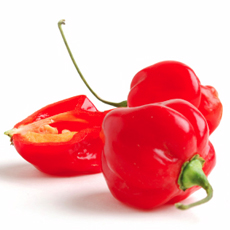 Hotter by design: The savina habanero was bred from the habanero to be hotter and larger. Photo by Avriette | Wikimedia.
Hotter by design: The savina habanero was bred from the habanero to be hotter and larger. Photo by Avriette | Wikimedia.
October 2005
Last Updated November 2025
|
 |
Product Reviews / Main Nibbles / Seasonings
Chile Pepper Type
Chile Glossary Page 8: Types Of Chiles ~ R To Z
This is Page 8 of an eight-page article. Click on the black links below to see other pages. See all of our delicious food glossaries.
This glossary is protected by copyright and cannot be reproduced in whole or in part. You are welcome to link to it.
RED BELL PEPPER
See bell pepper.
|
RED SAVINA CHILE
See savina habanero, below.
ROCOTO CHILE
The rocoto comes from the capsicum (chile) species, C. pubescens species, found primarily in Central and South America. The name pubescens means hairy in Latin; it refers to the hairy/furry leaves of the plant.
|
|
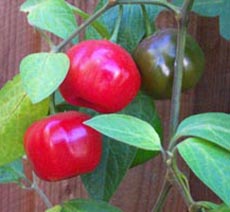
Rocoto chile. Photo by Joe Carrasco | Wikimedia. |
|
SAVINA HABANERO CHILE
The savina is a cultivar of the habanero chile (Capsicum chinense jacquin). At 577,000 Scoville Heat Units (SHUs), it is 65 times hotter than the jalapeño; typical habaneros range from 200,000 to 300,000 SHUs. The savina was the record holder as the world’s hottest chile until the discovery of the bhut jolokia, and was featured in the Guinness Book of Records as the “World's Hottest Spice.” The savina habanero was developed and cultivated by GNS Spices of Southern California. It was selectively bred to produce hotter, heavier, and larger fruit. Why? Because of the consumer demand for hotter and hotter.
|
|
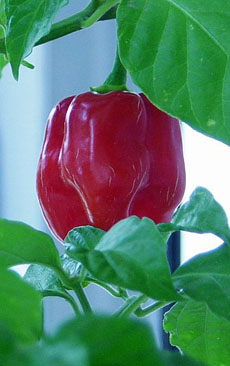
The savina habanero chile. Photo by Avriette | Wikimedia. |
|
SCOTCH BONNET CHILE
A variety of chile similar to, and of the same species as, the habanero. It is found mainly in the Caribbean islands, with a shape resembling a Scot’s bonnet. Most Scotch bonnets have a heat rating of 150,000 to 325,000 Scoville Units. They are used in many different sauces worldwide. If eaten raw by those unaccustomed to eating hot chiles, they can cause dizziness, numbness of hands and cheeks as well as severe heartburn.
SCOVILLE UNIT or SCOVILLE HEAT UNIT or SHU
A unit measuring the concentration of capsaicin, the “hot” ingredient in chiles. A measurement of 50,000 Scoville Units means that an extract from the chile can be diluted 50,000:1 with sugared water, and the “burn” of the capsaicin will be barely detectable by the human tongue. The methodology was invented in 1912 by the American pharmacologist Wilbur L. Scoville, who was working on the use of capsaicin in the muscle pain-relieving ointment Heet.
|
|
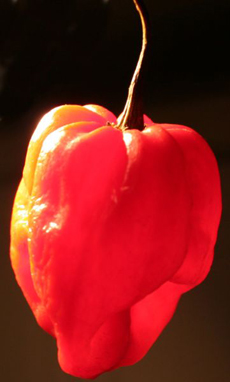
Woo hoo hot: a Scotch bonnet chile. Photo by Richard W.M. Jones | Wikimedia. |
Chiles have capsaicin concentrations from zero (or negligible), i.e., bell peppers, to 580,000 Scoville units, i.e., red savina habanero chiles. More about Scoville heat units and the Scoville Scale.
|
SERRANO CHILE
The serrano chile originated in the mountains of the Mexican states of Hidalgo and Puebla. The name is a reference to the mountains (sierras). The plants have distinctly fuzzy leaves and stems. Unripe serranos, like most chiles, are green when unripe; at maturity, they can be brown, green, orange, red, or yellow. The serrano is a hot chile—8 on a scale of 10. Small and thin, it is popular for its hot, clean flavor with notes of citrus. It can be used cooked or raw, chopped or ground, and is popular in salsas, stir-fries, and particularly with seafood. Serrano is a good choice with Asian dishes, as its flavor blends well with cilantro, garlic, lime, mint, onion, and vinegar.
|
|
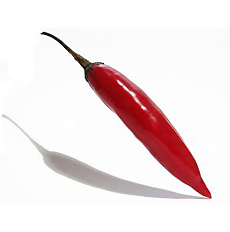
Serrano chile. Photo by Erik Araujo | SXC. |
SHIMLA MIRCH
The term for capsicum in India.
SHU
Scoville Heat Unit. See above.
TERROIR
Terroir (tur-WAH) comes from the French word for land, terre. It is loosely translated as “a sense of place.” Originally used in the wine industry, the term refers to the special characteristics that each unique climate, microclimate, geography (from latitude and longitude down to the slope of the particular piece of land), and geology (the soil components) can be found in agricultural products grown in the area. The same rootstock planted in different terroirs produces distinctly different flavors and aromas. Conversely, agricultural sites in the same area share similar soil, weather conditions, and so forth, and thus produce similar flavors and aromas.
TRINIDAD MORUGA SCORPION CHILE
One of the two ultra-hot chiles of Trinidad and Tobago. See Moruga scorpion chile. Other local chiles include the Congo Black (chocolate habanero), Congo Red, Scotch Bonnet, Trinidad Bird, and Yellow Habanero.
|
TRINIDAD 7 POT PEPPER or 7 POD PEPPER
A habanero-based chile from Trinidad and Tobago that is similar in heat to the bhut jolokia, but with the fruitier, nuttier flavors of the Caribbean. It was developed in the Chaguanas region of Trinidad. The name refers to the claim that one chile is so hot, it can be divided among seven pots of stew. The variety is not yet grown commercially, but on small rural farms. Some varieties grow to the size of golf balls.
|
|
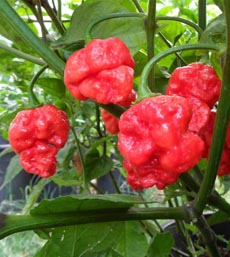
Trinidad 7 Pot chiles. Photo courtesy RefiningFireChiles.com. |
|
URFA BIBER or URFA CHILE or ISOT PEPPER
From the Urfa region of Turkey, the urfa chile is Capsicum annuum that develops sweet and smoky flavors, with notes of dried fruit (often raisins) and tobacco, thanks to its terroir. Ripening from red to a purple color, it is used to give deep color and flavor to foods, particularly meat, poultry, and fish. The medium-heat chile (5 on a scale of 10), is known to have a more lasting build of heat. Outside of the Middle East, the chile is most often found in crushed flake form. The chiles are prepared through “sweating”: sun-dried during the day and wrapped tightly at night to keep in the moisture. The result is a less spicy chile with a more lasting heat.
|
|

Dried, crushed urfa biber chiles. Photo courtesy LezzetSpices.com. |
Go To Page 1: History Of The Chile
Go To Article Index Above
Lifestyle Direct, Inc. All rights reserved. Images are the copyright of their respective owners.

|










